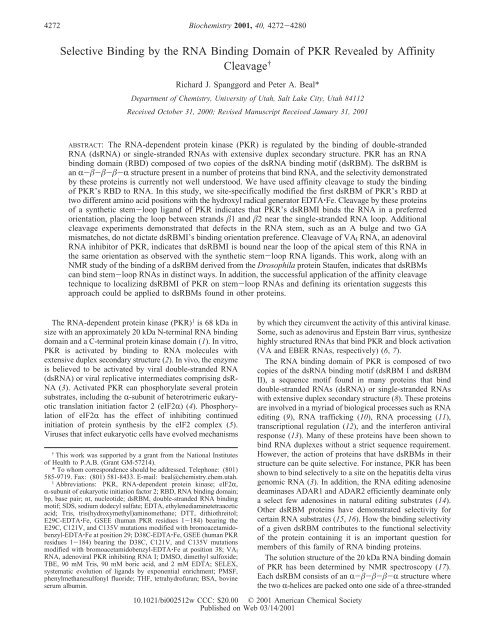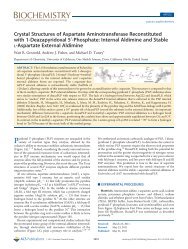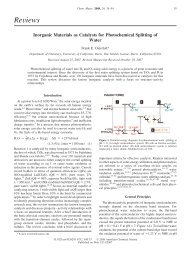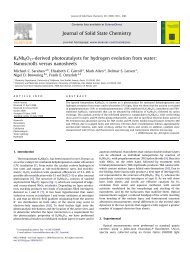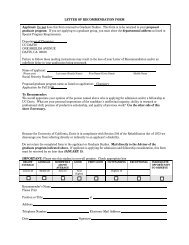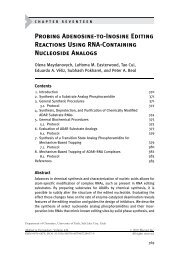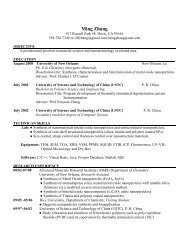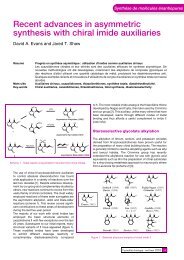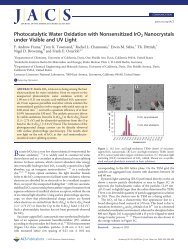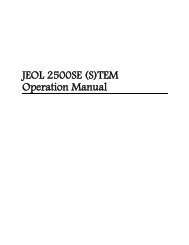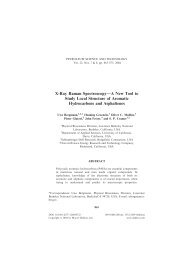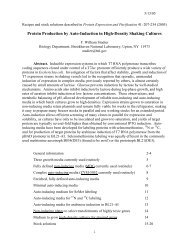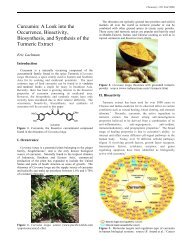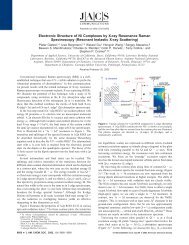Selective Binding by the RNA Binding Domain of PKR Revealed by ...
Selective Binding by the RNA Binding Domain of PKR Revealed by ...
Selective Binding by the RNA Binding Domain of PKR Revealed by ...
You also want an ePaper? Increase the reach of your titles
YUMPU automatically turns print PDFs into web optimized ePapers that Google loves.
4272 Biochemistry 2001, 40, 4272-4280<br />
<strong>Selective</strong> <strong>Binding</strong> <strong>by</strong> <strong>the</strong> <strong>RNA</strong> <strong>Binding</strong> <strong>Domain</strong> <strong>of</strong> <strong>PKR</strong> <strong>Revealed</strong> <strong>by</strong> Affinity<br />
Cleavage †<br />
Richard J. Spanggord and Peter A. Beal*<br />
Department <strong>of</strong> Chemistry, UniVersity <strong>of</strong> Utah, Salt Lake City, Utah 84112<br />
ReceiVed October 31, 2000; ReVised Manuscript ReceiVed January 31, 2001<br />
ABSTRACT: The <strong>RNA</strong>-dependent protein kinase (<strong>PKR</strong>) is regulated <strong>by</strong> <strong>the</strong> binding <strong>of</strong> double-stranded<br />
<strong>RNA</strong> (ds<strong>RNA</strong>) or single-stranded <strong>RNA</strong>s with extensive duplex secondary structure. <strong>PKR</strong> has an <strong>RNA</strong><br />
binding domain (RBD) composed <strong>of</strong> two copies <strong>of</strong> <strong>the</strong> ds<strong>RNA</strong> binding motif (dsRBM). The dsRBM is<br />
an R----R structure present in a number <strong>of</strong> proteins that bind <strong>RNA</strong>, and <strong>the</strong> selectivity demonstrated<br />
<strong>by</strong> <strong>the</strong>se proteins is currently not well understood. We have used affinity cleavage to study <strong>the</strong> binding<br />
<strong>of</strong> <strong>PKR</strong>’s RBD to <strong>RNA</strong>. In this study, we site-specifically modified <strong>the</strong> first dsRBM <strong>of</strong> <strong>PKR</strong>’s RBD at<br />
two different amino acid positions with <strong>the</strong> hydroxyl radical generator EDTA‚Fe. Cleavage <strong>by</strong> <strong>the</strong>se proteins<br />
<strong>of</strong> a syn<strong>the</strong>tic stem-loop ligand <strong>of</strong> <strong>PKR</strong> indicates that <strong>PKR</strong>’s dsRBMI binds <strong>the</strong> <strong>RNA</strong> in a preferred<br />
orientation, placing <strong>the</strong> loop between strands 1 and 2 near <strong>the</strong> single-stranded <strong>RNA</strong> loop. Additional<br />
cleavage experiments demonstrated that defects in <strong>the</strong> <strong>RNA</strong> stem, such as an A bulge and two GA<br />
mismatches, do not dictate dsRBMI’s binding orientation preference. Cleavage <strong>of</strong> VAI <strong>RNA</strong>, an adenoviral<br />
<strong>RNA</strong> inhibitor <strong>of</strong> <strong>PKR</strong>, indicates that dsRBMI is bound near <strong>the</strong> loop <strong>of</strong> <strong>the</strong> apical stem <strong>of</strong> this <strong>RNA</strong> in<br />
<strong>the</strong> same orientation as observed with <strong>the</strong> syn<strong>the</strong>tic stem-loop <strong>RNA</strong> ligands. This work, along with an<br />
NMR study <strong>of</strong> <strong>the</strong> binding <strong>of</strong> a dsRBM derived from <strong>the</strong> Drosophila protein Staufen, indicates that dsRBMs<br />
can bind stem-loop <strong>RNA</strong>s in distinct ways. In addition, <strong>the</strong> successful application <strong>of</strong> <strong>the</strong> affinity cleavage<br />
technique to localizing dsRBMI <strong>of</strong> <strong>PKR</strong> on stem-loop <strong>RNA</strong>s and defining its orientation suggests this<br />
approach could be applied to dsRBMs found in o<strong>the</strong>r proteins.<br />
The <strong>RNA</strong>-dependent protein kinase (<strong>PKR</strong>) 1 is 68 kDa in<br />
size with an approximately 20 kDa N-terminal <strong>RNA</strong> binding<br />
domain and a C-terminal protein kinase domain (1). In vitro,<br />
<strong>PKR</strong> is activated <strong>by</strong> binding to <strong>RNA</strong> molecules with<br />
extensive duplex secondary structure (2). In vivo, <strong>the</strong> enzyme<br />
is believed to be activated <strong>by</strong> viral double-stranded <strong>RNA</strong><br />
(ds<strong>RNA</strong>) or viral replicative intermediates comprising dsR-<br />
NA (3). Activated <strong>PKR</strong> can phosphorylate several protein<br />
substrates, including <strong>the</strong> R-subunit <strong>of</strong> heterotrimeric eukaryotic<br />
translation initiation factor 2 (eIF2R) (4). Phosphorylation<br />
<strong>of</strong> eIF2R has <strong>the</strong> effect <strong>of</strong> inhibiting continued<br />
initiation <strong>of</strong> protein syn<strong>the</strong>sis <strong>by</strong> <strong>the</strong> eIF2 complex (5).<br />
Viruses that infect eukaryotic cells have evolved mechanisms<br />
† This work was supported <strong>by</strong> a grant from <strong>the</strong> National Institutes<br />
<strong>of</strong> Health to P.A.B. (Grant GM-57214).<br />
* To whom correspondence should be addressed. Telephone: (801)<br />
585-9719. Fax: (801) 581-8433. E-mail: beal@chemistry.chem.utah.<br />
1 Abbreviations: <strong>PKR</strong>, <strong>RNA</strong>-dependent protein kinase; eIF2R,<br />
R-subunit <strong>of</strong> eukaryotic initiation factor 2; RBD, <strong>RNA</strong> binding domain;<br />
bp, base pair; nt, nucleotide; dsRBM, double-stranded <strong>RNA</strong> binding<br />
motif; SDS, sodium dodecyl sulfate; EDTA, ethylenediaminetetraacetic<br />
acid; Tris, tris(hydroxymethyl)aminomethane; DTT, dithiothreitol;<br />
E29C-EDTA‚Fe, GSEE (human <strong>PKR</strong> residues 1-184) bearing <strong>the</strong><br />
E29C, C121V, and C135V mutations modified with bromoacetamidobenzyl-EDTA‚Fe<br />
at position 29; D38C-EDTA‚Fe, GSEE (human <strong>PKR</strong><br />
residues 1-184) bearing <strong>the</strong> D38C, C121V, and C135V mutations<br />
modified with bromoacetamidobenzyl-EDTA‚Fe at position 38; VAI<br />
<strong>RNA</strong>, adenoviral <strong>PKR</strong> inhibiting <strong>RNA</strong> I; DMSO, dimethyl sulfoxide;<br />
TBE, 90 mM Tris, 90 mM boric acid, and 2 mM EDTA; SELEX,<br />
systematic evolution <strong>of</strong> ligands <strong>by</strong> exponential enrichment; PMSF,<br />
phenylmethanesulfonyl fluoride; THF, tetrahydr<strong>of</strong>uran; BSA, bovine<br />
serum albumin.<br />
<strong>by</strong> which <strong>the</strong>y circumvent <strong>the</strong> activity <strong>of</strong> this antiviral kinase.<br />
Some, such as adenovirus and Epstein Barr virus, syn<strong>the</strong>size<br />
highly structured <strong>RNA</strong>s that bind <strong>PKR</strong> and block activation<br />
(VA and EBER <strong>RNA</strong>s, respectively) (6, 7).<br />
The <strong>RNA</strong> binding domain <strong>of</strong> <strong>PKR</strong> is composed <strong>of</strong> two<br />
copies <strong>of</strong> <strong>the</strong> ds<strong>RNA</strong> binding motif (dsRBM I and dsRBM<br />
II), a sequence motif found in many proteins that bind<br />
double-stranded <strong>RNA</strong>s (ds<strong>RNA</strong>) or single-stranded <strong>RNA</strong>s<br />
with extensive duplex secondary structure (8). These proteins<br />
are involved in a myriad <strong>of</strong> biological processes such as <strong>RNA</strong><br />
editing (9), <strong>RNA</strong> trafficking (10), <strong>RNA</strong> processing (11),<br />
transcriptional regulation (12), and <strong>the</strong> interferon antiviral<br />
response (13). Many <strong>of</strong> <strong>the</strong>se proteins have been shown to<br />
bind <strong>RNA</strong> duplexes without a strict sequence requirement.<br />
However, <strong>the</strong> action <strong>of</strong> proteins that have dsRBMs in <strong>the</strong>ir<br />
structure can be quite selective. For instance, <strong>PKR</strong> has been<br />
shown to bind selectively to a site on <strong>the</strong> hepatitis delta virus<br />
genomic <strong>RNA</strong> (3). In addition, <strong>the</strong> <strong>RNA</strong> editing adenosine<br />
deaminases ADAR1 and ADAR2 efficiently deaminate only<br />
a select few adenosines in natural editing substrates (14).<br />
O<strong>the</strong>r dsRBM proteins have demonstrated selectivity for<br />
certain <strong>RNA</strong> substrates (15, 16). How <strong>the</strong> binding selectivity<br />
<strong>of</strong> a given dsRBM contributes to <strong>the</strong> functional selectivity<br />
<strong>of</strong> <strong>the</strong> protein containing it is an important question for<br />
members <strong>of</strong> this family <strong>of</strong> <strong>RNA</strong> binding proteins.<br />
The solution structure <strong>of</strong> <strong>the</strong> 20 kDa <strong>RNA</strong> binding domain<br />
<strong>of</strong> <strong>PKR</strong> has been determined <strong>by</strong> NMR spectroscopy (17).<br />
Each dsRBM consists <strong>of</strong> an R----R structure where<br />
<strong>the</strong> two R-helices are packed onto one side <strong>of</strong> a three-stranded<br />
10.1021/bi002512w CCC: $20.00 © 2001 American Chemical Society<br />
Published on Web 03/14/2001
Cleavage with <strong>the</strong> EDTA‚Fe-Modified <strong>PKR</strong> <strong>RNA</strong> <strong>Binding</strong> <strong>Domain</strong> Biochemistry, Vol. 40, No. 14, 2001 4273<br />
-sheet. The two dsRBMs <strong>of</strong> <strong>PKR</strong> are separated <strong>by</strong> a 22residue<br />
linker <strong>of</strong> poorly defined structure. Although <strong>the</strong>re<br />
have been no reports <strong>of</strong> high-resolution structural data on a<br />
<strong>PKR</strong>-<strong>RNA</strong> complex, structures <strong>of</strong> protein-<strong>RNA</strong> complexes<br />
involving motifs from two o<strong>the</strong>r members <strong>of</strong> <strong>the</strong> dsRBM<br />
family have been reported (18, 19). In <strong>the</strong> crystal structure<br />
<strong>of</strong> dsRBMII from <strong>the</strong> Xenopus laeVis protein Xlrbpa bound<br />
to duplex <strong>RNA</strong>, <strong>the</strong> protein contacts 16 bp <strong>of</strong> ds<strong>RNA</strong> along<br />
one face <strong>of</strong> <strong>the</strong> helix, crossing <strong>the</strong> major groove and<br />
contacting two adjacent minor grooves (18). Interestingly,<br />
<strong>the</strong> protein binding site in this structure is composed <strong>of</strong><br />
nucleotides from two 10 bp duplexes stacked end to end with<br />
<strong>the</strong> dsRBM straddling a major groove that deviates from<br />
perfect A-form geometry at <strong>the</strong> junction. Specificity for <strong>RNA</strong><br />
over DNA for <strong>the</strong> dsRBM is explained <strong>by</strong> <strong>the</strong> numerous<br />
contacts between <strong>the</strong> protein and <strong>the</strong> 2′-OH groups in <strong>the</strong><br />
minor groove in this structure (20). The few contacts between<br />
<strong>the</strong> protein and <strong>RNA</strong> bases also explained <strong>the</strong> lack <strong>of</strong> a rigid<br />
requirement <strong>of</strong> a specific sequence <strong>of</strong> duplex <strong>RNA</strong> in <strong>the</strong><br />
binding <strong>of</strong> dsRBM proteins (8). In <strong>the</strong> NMR structure <strong>of</strong><br />
dsRBMIII from <strong>the</strong> Drosophila protein Staufen bound to a<br />
stem-loop <strong>RNA</strong>, <strong>the</strong> single-stranded <strong>RNA</strong> loop is bound<br />
<strong>by</strong> <strong>the</strong> N-terminal R-helix (R1) <strong>of</strong> <strong>the</strong> dsRBM (19). This<br />
result indicated that <strong>the</strong> dsRBM is a more versatile <strong>RNA</strong><br />
binding module than previously recognized as it can simultaneously<br />
bind to both duplex and single-stranded <strong>RNA</strong>.<br />
Indeed, it was suggested that interactions between dsRBM<br />
R1 and single-stranded loop sequences may be a general<br />
mechanism <strong>by</strong> which specificity arises in <strong>the</strong> binding <strong>of</strong><br />
dsRBM proteins to stem-loop <strong>RNA</strong>s (19). Nagel and Ares<br />
recently proposed that <strong>the</strong> specificity <strong>of</strong> <strong>the</strong> yeast RNaseIII<br />
homologue Rnt1p for certain stem-loop substrates may arise<br />
from <strong>the</strong> interaction <strong>of</strong> <strong>the</strong> AGNN loop sequence with amino<br />
acid residues found between strands 1 and 2 <strong>of</strong> <strong>the</strong> Rnt1p’s<br />
dsRBM (15). This model invokes a binding orientation on<br />
<strong>the</strong> stem-loop <strong>RNA</strong> substrate which is <strong>the</strong> opposite <strong>of</strong> that<br />
found in <strong>the</strong> Staufen-<strong>RNA</strong> NMR structure. Thus, even with<br />
two high-resolution structures <strong>of</strong> dsRBMs bound to <strong>RNA</strong><br />
available, <strong>the</strong> orientation <strong>of</strong> a given dsRBM on a stemloop<br />
<strong>RNA</strong> and, <strong>the</strong>refore, <strong>the</strong> amino acids in proximity to<br />
<strong>the</strong> single-stranded loop, cannot be predicted and must be<br />
defined experimentally.<br />
In our ongoing work related to understanding <strong>the</strong> <strong>RNA</strong><br />
regulation <strong>of</strong> <strong>PKR</strong>, we prepared site-specifically modified<br />
proteins consisting <strong>of</strong> <strong>PKR</strong>’s 20 kDa <strong>RNA</strong> binding domain<br />
(RBD) (21). These modified proteins have functional groups<br />
introduced at different positions to help define features <strong>of</strong><br />
<strong>PKR</strong>-<strong>RNA</strong> complexes. Here we show that <strong>PKR</strong> RBD<br />
proteins modified with EDTA‚Fe at two different positions<br />
cleave <strong>RNA</strong> ligands selectively. The cleavage patterns that<br />
are generated reveal features <strong>of</strong> <strong>the</strong> <strong>PKR</strong>-<strong>RNA</strong> complexes.<br />
For instance, cleavage <strong>of</strong> a syn<strong>the</strong>tic stem-loop ligand <strong>of</strong><br />
<strong>PKR</strong> indicates that <strong>PKR</strong> binds this <strong>RNA</strong> with a preferred<br />
orientation, placing <strong>the</strong> loop between 1 and 2 <strong>of</strong> dsRBMI<br />
near <strong>the</strong> single-stranded <strong>RNA</strong> loop (22). This binding mode<br />
is different from that observed for Staufen dsRBMIII bound<br />
to a stem-loop structure and similar to that proposed for<br />
<strong>the</strong> binding <strong>of</strong> Rnt1p to stem-loop substrates. Removal <strong>of</strong><br />
<strong>the</strong> A bulge and two GA mismatches found in this <strong>RNA</strong>,<br />
creating a perfectly matched duplex stem, does not alter <strong>the</strong><br />
binding preference, suggesting that this preference originates<br />
from ei<strong>the</strong>r <strong>the</strong> single-stranded loop or <strong>the</strong> sequence <strong>of</strong> <strong>the</strong><br />
duplex itself. Cleavage <strong>of</strong> <strong>the</strong> adenovirus VAI <strong>RNA</strong> with<br />
<strong>the</strong> EDTA‚Fe-modified proteins indicates that dsRBMI binds<br />
near <strong>the</strong> loop <strong>of</strong> <strong>the</strong> apical stem <strong>of</strong> <strong>the</strong> <strong>RNA</strong> in <strong>the</strong> same<br />
orientation as with <strong>the</strong> syn<strong>the</strong>tic stem-loop <strong>RNA</strong>s. Toge<strong>the</strong>r,<br />
<strong>the</strong>se results indicate that proteins from <strong>the</strong> dsRBM family<br />
can selectively bind stem-loop <strong>RNA</strong>s in distinct ways.<br />
Fur<strong>the</strong>rmore, <strong>the</strong> successful application <strong>of</strong> <strong>the</strong> affinity<br />
cleavage technique to localizing dsRBMI <strong>of</strong> <strong>PKR</strong> on stemloop<br />
<strong>RNA</strong>s and defining its orientation suggests this approach<br />
could be used to study <strong>the</strong> binding selectivity <strong>of</strong> o<strong>the</strong>r dsRBM<br />
proteins.<br />
MATERIALS AND METHODS<br />
General. Distilled, deionized water was used for all<br />
aqueous reactions and dilutions. Biochemical reagents were<br />
obtained from Sigma/Aldrich unless o<strong>the</strong>rwise noted. Restriction<br />
enzymes and nucleic acid-modifying enzymes were<br />
purchased from Pharmacia, Boehringer-Mannheim, or New<br />
England Biolabs. Oligonucleotides were prepared on a<br />
Perkin-Elmer/ABI model 392 DNA/<strong>RNA</strong> syn<strong>the</strong>sizer with<br />
-cyanoethyl phosphoramidites. 5′-Dimethoxytrityl-protected<br />
2′-deoxyadenosine, 2′-deoxyguanosine, 2′-deoxycytidine, and<br />
thymidine phosphoramidites were purchased from Perkin-<br />
Elmer/ABI. 5′-Dimethoxytrityl-2′-tert-butyldimethylsilylprotected<br />
adenosine, guanosine, cytidine, and uridine phosphoramidites<br />
were purchased from Glen Research. [γ- 32 P]ATP<br />
(6000 Ci/mmol) was obtained from DuPont NEN. Storage<br />
phosphor autoradiography was carried out using imaging<br />
plates purchased from Kodak. A Molecular Dynamics<br />
STORM 840 instrument was used to obtain all data from<br />
phosphor imaging plates. Bromoacetamidobenzyl-EDTA‚Fe<br />
was kindly provided <strong>by</strong> C. Meares at <strong>the</strong> University <strong>of</strong><br />
California, Davis (Davis, CA). All NMR and crystal structures<br />
were visualized on a Silicon Graphics O2 workstation<br />
running Insight II (Biosym).<br />
Construction <strong>of</strong> <strong>the</strong> <strong>PKR</strong> RBD Single-Cysteine Mutants.<br />
As described previously (21), mutants <strong>of</strong> <strong>the</strong> <strong>PKR</strong> RBD<br />
(amino acids 1-184) were obtained as glutathione Stransferase<br />
(GST) fusion proteins <strong>by</strong> expression in Escherichia<br />
coli using <strong>the</strong> bacterial expression plasmid pGEX-2T<br />
(Pharmacia). An expression plasmid for <strong>the</strong> cysteine-free<br />
<strong>PKR</strong> RBD was constructed as previously described (21).<br />
PCR mutagenesis was used to introduce single-cysteine<br />
mutations into <strong>the</strong> cysteine-free <strong>PKR</strong> RBD expression<br />
plasmid. The following primers were used: E29C (mutagenic<br />
oligo), 5′-TCCTGAATTAGGCAGACATTGATATTTAA-<br />
GTAC-3′; D38C (5′ mutagenic oligo), 5′-CCTAATTCaggacctCCACATTGTAGGAGGTTT-3′;<br />
and <strong>PKR</strong> RBD template<br />
primers, 5′-GCGTGAggatccGAAGAAATGGCTGGT-<br />
GATCTT-3′ (5′ primer) and 5′-TCACGCGGTACCTTAA-<br />
GTAGCAAAAGAACCAGAGGA-3′ (3′ primer). Lowercase<br />
nucleotides represent incorporated restriction sites (D38C<br />
PpuMI and <strong>PKR</strong> RBD template 5′ primer BamHI), and<br />
underlined nucleotides represent introduced cysteine mutations.<br />
All single-cysteine mutations were verified <strong>by</strong> DNA<br />
sequencing.<br />
Expression and Purification <strong>of</strong> <strong>PKR</strong> RBD Proteins. <strong>PKR</strong><br />
RBD expression and purification were performed as previously<br />
described (21). Briefly, <strong>the</strong> BL-21 E. coli-expressed<br />
GST fusion <strong>PKR</strong> RBD was incubated with glutathione-<br />
Sepharose for 3hat4°C. Unbound proteins were removed
4274 Biochemistry, Vol. 40, No. 14, 2001 Spanggord and Beal<br />
<strong>by</strong> successive washes with glutathione-Sepharose buffer [20<br />
mM Tris-HCl (pH 8.3), 1 mM DTT, and 1 mM PMSF] and<br />
thrombin buffer [120 mM Tris-HCl (pH 8.6), 150 mM NaCl,<br />
and 7 mM CaCl2]. The GST domain was removed <strong>by</strong><br />
incubating <strong>the</strong> fusion protein with 60 units <strong>of</strong> thrombin for<br />
12hat4°C, and <strong>the</strong> reaction was quenched with <strong>the</strong> addition<br />
<strong>of</strong> PMSF (1 mM final concentration).<br />
Preparation <strong>of</strong> <strong>RNA</strong> Ligands <strong>of</strong> <strong>PKR</strong>. Generation <strong>of</strong> <strong>the</strong><br />
syn<strong>the</strong>tic stem-loop ligands <strong>of</strong> <strong>PKR</strong> was performed on a<br />
Perkin-Elmer DNA/<strong>RNA</strong> syn<strong>the</strong>sizer. Deprotection <strong>of</strong> <strong>the</strong><br />
syn<strong>the</strong>tic oligoribonucleotides was carried out in NH3saturated<br />
methanol for 24 h at room temperature followed<br />
<strong>by</strong> 1 M tetrabutylammonium fluoride in THF for 36 h at<br />
room temperature. Deprotected oligonucleotides were desalted<br />
on a NAP-25 column and purified <strong>by</strong> denaturing<br />
polyacrylamide gel electrophoresis. Purified <strong>RNA</strong> was<br />
visualized <strong>by</strong> UV shadowing, and extracted from <strong>the</strong> gel <strong>by</strong><br />
crushing and soaking in 0.5 M NH4OAc, 0.1% SDS, and<br />
0.1 mM EDTA overnight. The oligonucleotides were ethanol<br />
precipitated, and concentrations were estimated <strong>by</strong> UV<br />
absorbance at 260 nm. End-labeled stem-loop <strong>RNA</strong>s (5′-<br />
32 P) were prepared <strong>by</strong> incubating 10-20 pmol <strong>of</strong> <strong>RNA</strong> with<br />
[γ- 32 P]ATP (6000 Ci/mmol, DuPont) and T4 polynucleotide<br />
kinase for 1.5 h at 37 °C. Labeled <strong>RNA</strong> was purified on a<br />
16% polyacrylamide gel and extracted as described above.<br />
Labeled stem-loop <strong>RNA</strong>s (3′- 32 P) were prepared <strong>by</strong> treating<br />
20-30 pmol <strong>of</strong> <strong>RNA</strong> with [ 32 P]pCp (DuPont) and <strong>RNA</strong><br />
ligase for 3hat37°C and purified on a 16% denaturing<br />
polyacrylamide gel. Labeled <strong>RNA</strong> was isolated as described<br />
above.<br />
VAI <strong>RNA</strong> was generated <strong>by</strong> transcription with T7 <strong>RNA</strong><br />
polymerase. Generation <strong>of</strong> <strong>the</strong> necessary transcription template<br />
was performed as a three-piece ligation into <strong>the</strong> pAlter-1<br />
plasmid (Promega). The DNA template consisted <strong>of</strong> four<br />
syn<strong>the</strong>sized oligos (75mer and 77mer complement/82mer and<br />
80mer complement). The sequences <strong>of</strong> <strong>the</strong>se oligos are as<br />
follows: 75mer oligo, 5′-aattTCCGTGGTCTGGTGGA-<br />
TAAATTCGCAAGGGTATCATGGCGGACGACCGG-<br />
GGTTCGAACCCCGGATCCGGCC-3′; its complementary<br />
77mer oligo, 5′-GCGGACGGCCGGATCCGGGGT-<br />
TCGAACCCCGGTCGTCCGCCATGATACCC-TTGC-<br />
GAATTTATCCACCAGACCACGGA-3′; 82mer oligo, 5′-<br />
GTCCGCCGTGATCCATGCGGTTACCGCCC-<br />
GCGTGTCGAACCCAGGTGTGCGACGTCA-<br />
GACAACGGGGATGCGCTCCTTTAAA-3′;anditscomplementary<br />
80mer oligo, 5′-agctTTTAAAGGAGCGCATCCCC-<br />
GTTGTCTGACGTCGCACACCTGGGTTCGACACGCG-<br />
GGCGGTAACCGCATGGATCACG-3′. Bold nucleotides<br />
represent <strong>the</strong> VAI <strong>RNA</strong> sequence (23) (represented in <strong>the</strong><br />
75mer and 82mer oligos), and underlined nucleotides represent<br />
<strong>the</strong> complementary ends that will anneal to form a<br />
duplex insert containing <strong>the</strong> transcription template. Lowercase<br />
nucleotides represent <strong>the</strong> incorporated restriction sites<br />
that allow <strong>the</strong> ligation <strong>of</strong> <strong>the</strong> duplex insert into <strong>the</strong> EcoRIand<br />
HindIII-digested pAlter-1 plasmid (EcoRI overhang in<br />
<strong>the</strong> 75mer and HindIII overhang in <strong>the</strong> 80mer). The VAI<br />
<strong>RNA</strong>-DNA template was verified <strong>by</strong> DNA sequencing. T7<br />
<strong>RNA</strong> polymerase was used to generate <strong>the</strong> 159 nt VAI <strong>RNA</strong>.<br />
Transcription mixtures were heated to 70 °C for 10 min and<br />
<strong>the</strong>n purified on a 12% denaturing polyacrylamide gel. Bands<br />
were visualized via UV shadowing and excised from <strong>the</strong> gel<br />
<strong>by</strong> <strong>the</strong> crush and soak method described above. Labeled <strong>RNA</strong><br />
(5′- 32 P) was prepared <strong>by</strong> treating 100 pmol <strong>of</strong> transcript with<br />
shrimp alkaline phosphatase (SAP) for2hat37°C followed<br />
<strong>by</strong> phenol/chlor<strong>of</strong>orm extraction and ethanol precipitation.<br />
The SAP-treated transcript was purified and isolated as<br />
described above. Dephosphorylated <strong>RNA</strong> was labeled using<br />
polynucleotide kinase and [γ- 32 P]ATP and purified on a 12%<br />
denaturing polyacrylamide gel. Labeled <strong>RNA</strong> was isolated<br />
as described above. Labeling (3′- 32 P) <strong>of</strong> VAI <strong>RNA</strong> was<br />
performed as described above except dephosphorylated <strong>RNA</strong><br />
was used and purified on a 12% denaturing polyacrylamide<br />
gel.<br />
Bromoacetamidobenzyl-EDTA‚Fe Modification <strong>of</strong> Single-<br />
Cysteine <strong>PKR</strong> RBD Mutants. Conjugation <strong>of</strong> <strong>the</strong> <strong>PKR</strong> RBD<br />
cysteine mutants with <strong>the</strong> nucleic acid cleaving reagent<br />
bromoacetamidobenzyl-EDTA‚Fe was performed initially <strong>by</strong><br />
incubating 300 µL <strong>of</strong>a100-250 µM <strong>PKR</strong> RBD solution<br />
with 1 mM DTT for 12 h at 4 °C. The solution was dialyzed<br />
into degassed modification buffer [10 mM Hepes (pH 8.0),<br />
0.1 M NaCl, 5% glycerol, and 0.1 mM EDTA] until all <strong>the</strong><br />
DTT had been removed (3 h). The <strong>PKR</strong> RBD (250 µL<br />
solution) was mixed with 11.5 µL <strong>of</strong> a 26 mM solution <strong>of</strong><br />
bromoacetamidobenzyl-EDTA‚Fe (in DMSO) followed <strong>by</strong><br />
a 3 h incubation at 37 °C. Conjugation reactions were<br />
quenched <strong>by</strong> <strong>the</strong> removal <strong>of</strong> excess reagent with immediate<br />
dialysis into storage buffer [25 mM Tris-HCl (pH 7.0) and<br />
10 mM NaCl] in <strong>the</strong> dark at 4 °C. The derivatized <strong>PKR</strong> RBD<br />
concentration was determined <strong>by</strong> Bio-Rad protein assays with<br />
BSA as a protein standard. Bromoacetamidobenzyl-EDTA‚<br />
Fe-modified proteins were stored at -20 °C. The extent <strong>of</strong><br />
conjugation was analyzed via electrospray ionization mass<br />
spectrometry as previously described (21). The calculated<br />
molecular mass for <strong>PKR</strong> RBD (E29C/C121V/C135V)-<br />
EDTA‚Fe was 21 120 Da (found, 21 119 Da). The calculated<br />
molecular mass for <strong>PKR</strong> RBD (D38C/C121V/C135V)-<br />
EDTA‚Fe was 21 134 Da (found, 21 132 Da).<br />
Affinity CleaVage Experiments. <strong>RNA</strong> complexes with <strong>PKR</strong><br />
RBD-EDTA‚Fe conjugates were formed <strong>by</strong> incubating <strong>the</strong><br />
protein with 5′- and 3′-end-labeled <strong>RNA</strong> at room temperature<br />
for 7 min in 25 mM Tris-HCl (pH 7.0) and 10 mM NaCl.<br />
Protein-<strong>RNA</strong> complexes were analyzed via gel mobility<br />
shift assays as previously described (21). <strong>PKR</strong> RBD-<strong>RNA</strong><br />
complexes (20 µL final reaction volume) were probed <strong>by</strong><br />
initiating hydroxyl radical formation with 0.01% hydrogen<br />
peroxide and 5 mM sodium ascorbate followed <strong>by</strong> incubation<br />
at room temperature for 1 min. Reactions were quenched<br />
<strong>by</strong> <strong>the</strong> addition <strong>of</strong> 80 µL <strong>of</strong> distilled water followed <strong>by</strong><br />
phenol/chlor<strong>of</strong>orm extraction and ethanol precipitation.<br />
Cleaved <strong>RNA</strong> was resuspended into 10 µL <strong>of</strong> formamide<br />
loading dye and analyzed via denaturing polyacrylamide gel<br />
electrophoresis. Data were obtained from <strong>the</strong> gels using<br />
storage phosphor autoradiography and a STORM phosphorimager<br />
(Molecular Dynamics). Mapping <strong>of</strong> <strong>the</strong> cleavage data<br />
was performed using Image Quant s<strong>of</strong>tware (Molecular<br />
Dynamics). Traces were generated for gel lanes corresponding<br />
to <strong>RNA</strong> with unmodified or modified protein added in<br />
<strong>the</strong> presence <strong>of</strong> hydrogen peroxide and sodium ascorbate.<br />
Intensities <strong>of</strong> <strong>the</strong> cleavage bands were measured and mapped<br />
onto <strong>the</strong> secondary structures <strong>of</strong> each <strong>RNA</strong> that was studied.<br />
RESULTS<br />
CleaVage <strong>of</strong> Syn<strong>the</strong>tic Stem-Loop Ligands <strong>of</strong> <strong>PKR</strong> with<br />
Two Different RBD-EDTA‚Fe Proteins. To define structural
Cleavage with <strong>the</strong> EDTA‚Fe-Modified <strong>PKR</strong> <strong>RNA</strong> <strong>Binding</strong> <strong>Domain</strong> Biochemistry, Vol. 40, No. 14, 2001 4275<br />
FIGURE 1: Structure <strong>of</strong> <strong>the</strong> <strong>PKR</strong> RBD (amino acids 11-179)<br />
showing <strong>the</strong> locations <strong>of</strong> amino acids selected for mutagenesis in<br />
dsRBMI (red) along with <strong>the</strong> two natural cysteines in dsRBMII<br />
(blue) (17).<br />
features <strong>of</strong> <strong>PKR</strong> RBD-<strong>RNA</strong> complexes, we employed <strong>the</strong><br />
affinity cleavage technique. This approach involves <strong>the</strong><br />
covalent attachment <strong>of</strong> a nonselective cleavage reagent to<br />
specific positions in <strong>the</strong> nucleic acid binding molecule and<br />
analysis <strong>of</strong> <strong>the</strong> cleavage patterns generated <strong>by</strong> <strong>the</strong>se conjugates<br />
(24). This method was used to analyze <strong>the</strong> binding <strong>of</strong><br />
<strong>PKR</strong>’s <strong>RNA</strong> binding domain, which is located in <strong>the</strong> first<br />
184 amino acids <strong>of</strong> <strong>the</strong> protein (25). This domain can be<br />
expressed independently to high levels in bacteria and easily<br />
purified. Earlier, we demonstrated that two cysteine residues<br />
found naturally in <strong>PKR</strong>’s RBD are not essential for <strong>RNA</strong>regulated<br />
kinase activity (21). Fur<strong>the</strong>rmore, several singlecysteine<br />
mutants <strong>of</strong> <strong>PKR</strong>’s RBD could be modified with<br />
cysteine-specific reagents without significant loss <strong>of</strong> <strong>RNA</strong><br />
binding activity. To generate proteins for affinity cleavage<br />
experiments, we overexpressed two single-cysteine mutants<br />
<strong>of</strong> <strong>PKR</strong>’s RBD (E29C/C121V/C135V) and (D38C/C121V/<br />
C135V). The E29C mutation is located near <strong>the</strong> center <strong>of</strong><br />
dsRBMI along strand 1 (Figure 1). D38C is closer to one<br />
end <strong>of</strong> dsRBMI in loop 2 between strands 1 and 2 (Figure<br />
1). The two mutants were modified with <strong>the</strong> cysteine<br />
selective bromoacetamidobenzyl-EDTA‚Fe, introducing <strong>the</strong><br />
hydroxyl radical generator EDTA‚Fe at ei<strong>the</strong>r amino acid<br />
position 29 or 38 (26). Electrospray ionization mass spectrometry<br />
was used to confirm stoichiometric modification<br />
for both proteins (21). Gel mobility shift experiments with<br />
several <strong>RNA</strong>s showed <strong>the</strong> two modified proteins had similar<br />
binding affinities (data not shown).<br />
For our initial studies, we chose to analyze <strong>the</strong> cleavage<br />
patterns generated on a stem-loop <strong>RNA</strong> identified as <strong>the</strong><br />
minimal variant <strong>of</strong> a <strong>PKR</strong> ligand discovered in a SELEX<br />
experiment (22). This 46 nt syn<strong>the</strong>tic stem-loop <strong>RNA</strong> was<br />
prepared <strong>by</strong> automated <strong>RNA</strong> syn<strong>the</strong>sis and end labeled with<br />
FIGURE 2: Affinity cleaving <strong>of</strong> a syn<strong>the</strong>tic stem-loop ligand <strong>of</strong><br />
<strong>PKR</strong> using <strong>the</strong> EDTA‚Fe-modified E29C <strong>PKR</strong> RBD mutant. Shown<br />
at <strong>the</strong> left is a storage phosphor autoradiogram <strong>of</strong> a 16% denaturing<br />
polyacrylamide gel separating <strong>the</strong> 5′-end-labeled <strong>RNA</strong> cleavage<br />
products. Major cleavage sites are identified with letters and<br />
brackets. This <strong>RNA</strong> was 3′-end-labeled to investigate <strong>the</strong> 3′ end <strong>of</strong><br />
<strong>the</strong> <strong>RNA</strong> for any additional cleavage sites. No o<strong>the</strong>r major cleavage<br />
sites were observed: -OH, alkaline hydrolysis; T1, T1 RNase;<br />
lane 1, <strong>RNA</strong> with no added hydrogen peroxide or sodium ascorbate;<br />
lane 2, <strong>RNA</strong> in <strong>the</strong> presence <strong>of</strong> 0.01% hydrogen peroxide and 5<br />
mM sodium ascorbate; lane 3, 6 µM unmodified E29C <strong>PKR</strong> RBD<br />
and <strong>RNA</strong> with no added hydrogen peroxide or sodium ascorbate;<br />
lane 4, 6 µM unmodified E29C <strong>PKR</strong> RBD and <strong>RNA</strong> in <strong>the</strong> presence<br />
<strong>of</strong> 0.01% hydrogen peroxide and 5 mM sodium ascorbate; lane 5,<br />
6 µM EDTA‚Fe-modified E29C <strong>PKR</strong> RBD and <strong>RNA</strong> with no added<br />
hydrogen peroxide or sodium ascorbate; and lane 6, 6 µM EDTA‚<br />
Fe-modified E29C <strong>PKR</strong> RBD and <strong>RNA</strong> in <strong>the</strong> presence <strong>of</strong> 0.01%<br />
hydrogen peroxide and 5 mM sodium ascorbate. Shown at <strong>the</strong> right<br />
is <strong>the</strong> mapping <strong>of</strong> <strong>the</strong> major cleavage sites (identified <strong>by</strong> letters<br />
and brackets) on <strong>the</strong> stem-loop <strong>RNA</strong>’s predicted secondary<br />
structure. The secondary structure has been confirmed <strong>by</strong> mutagenesis<br />
experiments (22). Lines indicate sites <strong>of</strong> cleavage, and line<br />
lengths indicate relative cleavage efficiencies.<br />
32 P for <strong>the</strong> analysis (Figures 2 and 3). Importantly, <strong>the</strong> E29C-<br />
EDTA‚Fe conjugate cleaved <strong>the</strong> <strong>RNA</strong> selectively at <strong>the</strong> end<br />
<strong>of</strong> <strong>the</strong> duplex near <strong>the</strong> single-stranded loop (Figure 2). The<br />
cleavage was observed only with <strong>the</strong> EDTA‚Fe-modified<br />
protein and was dependent on <strong>the</strong> addition <strong>of</strong> hydrogen<br />
peroxide and sodium ascorbate (Figure 2, lanes 1-6). Thus,<br />
this cleavage arises from hydroxyl radicals generated from<br />
<strong>the</strong> covalently attached EDTA‚Fe, indicating that amino acid<br />
position 29 is in proximity (approximately
4276 Biochemistry, Vol. 40, No. 14, 2001 Spanggord and Beal<br />
FIGURE 3: Affinity cleaving <strong>of</strong> <strong>the</strong> syn<strong>the</strong>tic stem-loop ligand <strong>of</strong><br />
<strong>PKR</strong> using <strong>the</strong> EDTA‚Fe-modified D38C <strong>PKR</strong> RBD mutant. Shown<br />
at <strong>the</strong> left is a storage phosphor autoradiogram <strong>of</strong> a 16% denaturing<br />
polyacrylamide gel separating <strong>the</strong> 5′-end-labeled <strong>RNA</strong> cleavage<br />
products. Major cleavage sites are identified with letters and<br />
brackets. This <strong>RNA</strong> was 3′-end-labeled to investigate <strong>the</strong> 3′ end <strong>of</strong><br />
<strong>the</strong> <strong>RNA</strong> for any additional cleavage sites. No o<strong>the</strong>r major cleavage<br />
sites were observed: -OH, alkaline hydrolysis; T1, T1 RNase;<br />
lane 1, <strong>RNA</strong> with no added hydrogen peroxide or sodium ascorbate;<br />
lane 2, <strong>RNA</strong> in <strong>the</strong> presence <strong>of</strong> 0.01% hydrogen peroxide and 5<br />
mM sodium ascorbate; lane 3, 6 µM unmodified D38C <strong>PKR</strong> RBD<br />
and <strong>RNA</strong> with no added hydrogen peroxide or sodium ascorbate;<br />
lane 4, 6 µM unmodified D38C <strong>PKR</strong> RBD and <strong>RNA</strong> in <strong>the</strong> presence<br />
<strong>of</strong> 0.01% hydrogen peroxide and 5 mM sodium ascorbate; lane 5,<br />
6 µM EDTA‚Fe-modified D38C <strong>PKR</strong> RBD and <strong>RNA</strong> with no<br />
added hydrogen peroxide or sodium ascorbate; and lane 6, 6 µM<br />
EDTA‚Fe-modified D38C <strong>PKR</strong> RBD and <strong>RNA</strong> in <strong>the</strong> presence <strong>of</strong><br />
0.01% hydrogen peroxide and 5 mM sodium ascorbate. Shown at<br />
<strong>the</strong> right is <strong>the</strong> mapping <strong>of</strong> <strong>the</strong> major cleavage sites (identified <strong>by</strong><br />
letters and brackets) on <strong>the</strong> minimal binding <strong>RNA</strong> ligand’s<br />
secondary structure (22). C21, denoted with an asterisk, is cleaved<br />
in <strong>the</strong> absence <strong>of</strong> <strong>the</strong> EDTA‚Fe-modified protein and is not included<br />
in <strong>the</strong> mapping <strong>of</strong> EDTA‚Fe-<strong>PKR</strong> RBD specific cleavage sites.<br />
in a specific orientation placing loop 2 between 1 and 2<br />
near <strong>the</strong> <strong>RNA</strong> loop.<br />
Due to <strong>the</strong> observed binding preference <strong>of</strong> <strong>the</strong> <strong>PKR</strong>’s<br />
dsRBMI found with <strong>the</strong> stem-loop ligand, we examined<br />
whe<strong>the</strong>r this preference originated from <strong>the</strong> two GA mismatches<br />
and A bulge. A mutant <strong>RNA</strong> was constructed<br />
consisting <strong>of</strong> <strong>the</strong> stem-loop region where <strong>the</strong> two GA<br />
mismatches were converted to two Watson-Crick base pairs<br />
and <strong>the</strong> A bulge had been removed, creating a stem-loop<br />
sequence containing an uninterrupted 16 bp duplex (Figures<br />
4 and 5). The predicted secondary structure <strong>of</strong> this <strong>RNA</strong> is<br />
consistent with <strong>the</strong> relatively low reactivity <strong>of</strong> <strong>the</strong> nucleotides<br />
in <strong>the</strong> duplex stem under <strong>the</strong> conditions <strong>of</strong> both alkaline<br />
hydrolysis and T1 nuclease digestion compared to <strong>the</strong><br />
reactivity <strong>of</strong> nucleotides in <strong>the</strong> single-stranded loop (Figures<br />
4 and 5, lanes -OH and T1). Again, both <strong>the</strong> E29C- and<br />
D38C-EDTA‚Fe conjugates selectively cleaved this <strong>RNA</strong><br />
(Figures 4 and 5). With <strong>the</strong> E29C-EDTA‚Fe conjugate,<br />
cleavage was observed at <strong>the</strong> base <strong>of</strong> <strong>the</strong> loop in <strong>the</strong> duplexed<br />
region as observed with <strong>the</strong> original stem-loop ligand<br />
(compare Figures 2 and 4). Also, with <strong>the</strong> D38C-EDTA‚Fe<br />
conjugate, nucleotides in <strong>the</strong> loop <strong>of</strong> <strong>the</strong> <strong>RNA</strong> were observed<br />
to be cleaved most efficiently (compare Figures 3 and 5).<br />
Therefore, <strong>the</strong> <strong>PKR</strong> RBD binds this <strong>RNA</strong> at <strong>the</strong> same site<br />
FIGURE 4: Affinity cleaving <strong>of</strong> <strong>the</strong> mutant stem-loop ligand <strong>of</strong><br />
<strong>PKR</strong> using <strong>the</strong> EDTA‚Fe-modified E29C <strong>PKR</strong> RBD mutant. Shown<br />
at <strong>the</strong> left is a storage phosphor autoradiogram <strong>of</strong> a 16% denaturing<br />
polyacrylamide gel separating <strong>the</strong> 5′-end-labeled <strong>RNA</strong> cleavage<br />
products. Major cleavage sites are identified with letters and<br />
brackets. This <strong>RNA</strong> was 3′-end-labeled to investigate <strong>the</strong> 3′ end <strong>of</strong><br />
<strong>the</strong> <strong>RNA</strong> for any additional cleavage sites. No o<strong>the</strong>r major cleavage<br />
sites were observed: -OH, alkaline hydrolysis; T1, T1 RNase;<br />
lane 1, <strong>RNA</strong> with no added hydrogen peroxide or sodium ascorbate;<br />
lane 2, <strong>RNA</strong> in <strong>the</strong> presence <strong>of</strong> 0.01% hydrogen peroxide and 5<br />
mM sodium ascorbate; lane 3, 6 µM unmodified E29C <strong>PKR</strong> RBD<br />
and <strong>RNA</strong> with no added hydrogen peroxide or sodium ascorbate;<br />
lane 4, 6 µM unmodified E29C <strong>PKR</strong> RBD and <strong>RNA</strong> in <strong>the</strong> presence<br />
<strong>of</strong> 0.01% hydrogen peroxide and 5 mM sodium ascorbate; lane 5,<br />
6 µM EDTA‚Fe-modified E29C <strong>PKR</strong> RBD and <strong>RNA</strong> with no added<br />
hydrogen peroxide or sodium ascorbate; and lane 6, 6 µM EDTA‚<br />
Fe-modified E29C <strong>PKR</strong> RBD and <strong>RNA</strong> in <strong>the</strong> presence <strong>of</strong> 0.01%<br />
hydrogen peroxide and 5 mM sodium ascorbate. Shown at <strong>the</strong> right<br />
is <strong>the</strong> mapping <strong>of</strong> <strong>the</strong> major cleavage sites (identified <strong>by</strong> letters<br />
and brackets) on <strong>the</strong> mutant stem loop ligand’s secondary structure.<br />
in <strong>the</strong> same orientation as found with <strong>the</strong> original stemloop<br />
<strong>RNA</strong> ligand, indicating that <strong>the</strong> GA mismatches and<br />
<strong>the</strong> A bulge do not dictate <strong>the</strong> binding selectivity.<br />
CleaVage <strong>of</strong> <strong>the</strong> AdenoVirus <strong>PKR</strong> Inhibitor VAI <strong>RNA</strong>.<br />
Several naturally occurring <strong>RNA</strong> ligands <strong>of</strong> <strong>PKR</strong> have stemloop<br />
structures located in <strong>the</strong> <strong>PKR</strong> binding site (28, 29). To<br />
determine if <strong>PKR</strong>’s dsRBMI bound one <strong>of</strong> <strong>the</strong>se <strong>RNA</strong>s<br />
selectively, we analyzed <strong>the</strong> cleavage patterns generated <strong>by</strong><br />
E29C-EDTA‚Fe and D38C-EDTA‚Fe on VAI <strong>RNA</strong>, an<br />
inhibitor <strong>of</strong> <strong>PKR</strong>’s activation generated <strong>by</strong> adenovirus 2<br />
(Figures 6 and 7) (6). The E29C-EDTA‚Fe conjugate cleaved<br />
VAI <strong>RNA</strong> selectively with <strong>the</strong> most efficiently cleaved<br />
nucleotides located in base pairs near <strong>the</strong> loop end <strong>of</strong> <strong>the</strong><br />
apical stem (Figure 6). The location <strong>of</strong> <strong>the</strong>se cleavage sites<br />
was confirmed with 3′-end-labeled <strong>RNA</strong>. To ensure that <strong>the</strong>se<br />
cleavage events were due to <strong>the</strong> bound EDTA‚Fe-modified<br />
protein, we compared <strong>the</strong> cleavage products to those generated<br />
<strong>by</strong> free EDTA‚Fe and unmodified protein at <strong>the</strong> same<br />
concentration (Figure 6, lane 5). Although some sites cleaved<br />
in <strong>the</strong> presence <strong>of</strong> <strong>the</strong> E29C-EDTA‚Fe RBD were found with<br />
<strong>the</strong> free EDTA‚Fe (e.g., sites in <strong>the</strong> central domain and C68<br />
in <strong>the</strong> apical loop), <strong>the</strong> major cleavage sites in <strong>the</strong> stem near<br />
<strong>the</strong> apical loop were only detected with <strong>the</strong> RBD-EDTA‚Fe<br />
conjugate. Interestingly, Ma<strong>the</strong>ws had previously shown
Cleavage with <strong>the</strong> EDTA‚Fe-Modified <strong>PKR</strong> <strong>RNA</strong> <strong>Binding</strong> <strong>Domain</strong> Biochemistry, Vol. 40, No. 14, 2001 4277<br />
FIGURE 5: Affinity cleaving <strong>of</strong> <strong>the</strong> mutant stem-loop ligand <strong>of</strong><br />
<strong>PKR</strong> using <strong>the</strong> EDTA‚Fe-modified D38C <strong>PKR</strong> RBD mutant. Shown<br />
at <strong>the</strong> left is a storage phosphor autoradiogram <strong>of</strong> a 16% denaturing<br />
polyacrylamide gel separating <strong>the</strong> 5′-end-labeled <strong>RNA</strong> cleavage<br />
products. Major cleavage sites are identified with letters and<br />
brackets. This <strong>RNA</strong> was 3′-end-labeled to investigate <strong>the</strong> 3′ end <strong>of</strong><br />
<strong>the</strong> <strong>RNA</strong> for any additional cleavage sites. No o<strong>the</strong>r major cleavage<br />
sites were observed: -OH, alkaline hydrolysis; T1, T1 RNase;<br />
lane 1, <strong>RNA</strong> with no added hydrogen peroxide or sodium ascorbate;<br />
lane 2, <strong>RNA</strong> in <strong>the</strong> presence <strong>of</strong> 0.01% hydrogen peroxide and 5<br />
mM sodium ascorbate; lane 3, 6 µM unmodified D38C <strong>PKR</strong> RBD<br />
and <strong>RNA</strong> with no added hydrogen peroxide or 5 mM sodium<br />
ascorbate; lane 4, 6 µM unmodified D38C <strong>PKR</strong> RBD and <strong>RNA</strong> in<br />
<strong>the</strong> presence <strong>of</strong> 0.01% hydrogen peroxide and 5 mM sodium<br />
ascorbate; lane 5, 6 µM EDTA‚Fe-modified D38C <strong>PKR</strong> RBD and<br />
<strong>RNA</strong> with no added hydrogen peroxide or sodium ascorbate; and<br />
lane 6, 6 µM EDTA‚Fe-modified D38C <strong>PKR</strong> RBD and <strong>RNA</strong> in<br />
<strong>the</strong> presence <strong>of</strong> 0.01% hydrogen peroxide and 5 mM sodium<br />
ascorbate. Shown at <strong>the</strong> right is <strong>the</strong> mapping <strong>of</strong> <strong>the</strong> major cleavage<br />
sites (identified <strong>by</strong> letters and brackets) on <strong>the</strong> mutant stem loop<br />
ligand’s secondary structure. C20, denoted with an asterisk, is<br />
cleaved in <strong>the</strong> absence <strong>of</strong> <strong>the</strong> EDTA‚Fe-modified protein and is<br />
not included in <strong>the</strong> mapping <strong>of</strong> EDTA‚Fe-<strong>PKR</strong> RBD specific<br />
cleavage sites.<br />
using footprinting techniques that this stem structure was<br />
indeed <strong>the</strong> binding site on VAI <strong>RNA</strong> for both <strong>the</strong> RBD <strong>of</strong><br />
<strong>PKR</strong> and <strong>the</strong> full-length enzyme (3, 29). We also observe<br />
weak cleavage in <strong>the</strong> central domain <strong>of</strong> VAI <strong>RNA</strong> with this<br />
conjugate with little cleavage apparent in <strong>the</strong> terminal stem.<br />
With <strong>the</strong> D38C-EDTA‚Fe protein, <strong>the</strong> major cleavage<br />
pattern was located closer to <strong>the</strong> loop than observed with<br />
<strong>the</strong> E29C-EDTA‚Fe protein. The cleavage occurred at<br />
nucleotides that make up <strong>the</strong> stem-loop junction for <strong>the</strong><br />
apical stem (Figure 7). With this protein, little cleavage was<br />
detected in ei<strong>the</strong>r <strong>the</strong> central domain or <strong>the</strong> terminal stem.<br />
Taken toge<strong>the</strong>r, <strong>the</strong> results <strong>of</strong> <strong>the</strong> cleavage experiments<br />
indicate that position 29 <strong>of</strong> dsRBMI <strong>of</strong> <strong>PKR</strong> is located near<br />
base pairs at <strong>the</strong> loop end <strong>of</strong> <strong>the</strong> apical stem <strong>of</strong> VAI <strong>RNA</strong>,<br />
and position 38, which is in loop 2 <strong>of</strong> dsRBMI, is located<br />
closer to <strong>the</strong> <strong>RNA</strong> loop <strong>of</strong> <strong>the</strong> apical stem. This orientation<br />
<strong>of</strong> dsRBMI is <strong>the</strong> same as that observed for <strong>the</strong> syn<strong>the</strong>tic<br />
stem-loop <strong>RNA</strong>s described above.<br />
DISCUSSION<br />
Affinity cleavage experiments using proteins modified with<br />
nonselective nucleic acid cleavage reagents have proven to<br />
FIGURE 6: Affinity cleaving <strong>of</strong> <strong>the</strong> adenovirus VAI <strong>RNA</strong> (a <strong>PKR</strong><br />
kinase inhibitor) using <strong>the</strong> EDTA‚Fe-modified E29C <strong>PKR</strong> RBD<br />
mutant. Shown at <strong>the</strong> left is a storage phosphor autoradiogram <strong>of</strong><br />
a 12% denaturing polyacrylamide gel separating <strong>the</strong> 5′-end-labeled<br />
<strong>RNA</strong> cleavage products. Major cleavage sites are identified with<br />
letters and brackets. VAI <strong>RNA</strong> was 3′-end-labeled to investigate<br />
<strong>the</strong> 3′ end <strong>of</strong> <strong>the</strong> <strong>RNA</strong> for any additional cleavage sites. No o<strong>the</strong>r<br />
major cleavage sites were observed: -OH, alkaline hydrolysis;<br />
T1, T1 RNase; lane 1, <strong>RNA</strong> with no added hydrogen peroxide<br />
or sodium ascorbate; lane 2, <strong>RNA</strong> in <strong>the</strong> presence <strong>of</strong> 0.01%<br />
hydrogen peroxide and 5 mM sodium ascorbate; lane 3, 6 µM<br />
unmodified E29C <strong>PKR</strong> RBD and <strong>RNA</strong> with no added hydrogen<br />
peroxide or sodium ascorbate; lane 4, 6 µM unmodified E29C <strong>PKR</strong><br />
RBD and <strong>RNA</strong> in <strong>the</strong> presence <strong>of</strong> 0.01% hydrogen peroxide and 5<br />
mM sodium ascorbate; lane 5, 6 µM unmodified E29C <strong>PKR</strong> RBD<br />
and <strong>RNA</strong> in <strong>the</strong> presence <strong>of</strong> 6 µM free EDTA‚Fe with 0.01%<br />
hydrogen peroxide and 5 mM sodium ascorbate; lane 6, 6 µM<br />
EDTA‚Fe-modified E29C <strong>PKR</strong> RBD and <strong>RNA</strong> with no added<br />
hydrogen peroxide or sodium ascorbate; and lane 7, 6 µM EDTA‚<br />
Fe-modified E29C <strong>PKR</strong> RBD and <strong>RNA</strong> in <strong>the</strong> presence <strong>of</strong> 0.01%<br />
hydrogen peroxide and 5 mM sodium ascorbate. Shown at <strong>the</strong> right<br />
is <strong>the</strong> mapping <strong>of</strong> <strong>the</strong> major cleavage sites (identified <strong>by</strong> letters<br />
and brackets) on <strong>the</strong> secondary structure model <strong>of</strong> <strong>the</strong> adenovirus<br />
VAI <strong>RNA</strong>. C67, denoted with an asterisk, is cleaved in <strong>the</strong> absence<br />
<strong>of</strong> <strong>the</strong> EDTA‚Fe-modified protein and is not included in <strong>the</strong><br />
mapping <strong>of</strong> EDTA‚Fe-<strong>PKR</strong> RBD specific cleavage sites. Underlined<br />
nucleotides represent sequence changes made to facilitate<br />
cloning. This region <strong>of</strong> VAI <strong>RNA</strong> is outside <strong>the</strong> previously described<br />
<strong>PKR</strong> binding site (29).<br />
be useful in defining structural features <strong>of</strong> a variety <strong>of</strong><br />
complexes between nucleic acids and proteins (30-32).<br />
Given <strong>the</strong> fact that dsRBM-containing proteins can typically<br />
bind multiple <strong>RNA</strong>s and <strong>the</strong> binding site and orientation <strong>of</strong><br />
a dsRBM on an <strong>RNA</strong> ligand is <strong>of</strong>ten difficult to predict,<br />
affinity cleavage experiments have <strong>the</strong> potential to be<br />
valuable in fur<strong>the</strong>r defining <strong>the</strong> basis for <strong>the</strong> observed binding<br />
selectivity. However, to our knowledge, this work constitutes<br />
<strong>the</strong> first application <strong>of</strong> this technique to <strong>the</strong> study <strong>of</strong> a<br />
member <strong>of</strong> <strong>the</strong> dsRBM protein family. Here, we covalently<br />
attached EDTA‚Fe to different locations in dsRBMI <strong>of</strong> <strong>the</strong><br />
<strong>RNA</strong> binding domain <strong>of</strong> <strong>PKR</strong> and used <strong>the</strong>se proteins to<br />
study <strong>the</strong> complexes formed with <strong>RNA</strong>s containing stemloop<br />
structures. With all <strong>of</strong> <strong>the</strong> <strong>RNA</strong>s studied in this work,<br />
highly localized cleavage was observed with <strong>the</strong> EDTA‚Fe<br />
conjugates. The results demonstrate that <strong>the</strong>se <strong>RNA</strong>s have a<br />
limited number <strong>of</strong> binding sites for <strong>PKR</strong>. Indeed, <strong>the</strong>
4278 Biochemistry, Vol. 40, No. 14, 2001 Spanggord and Beal<br />
FIGURE 7: Affinity cleaving <strong>of</strong> <strong>the</strong> adenovirus VAI <strong>RNA</strong> using<br />
<strong>the</strong> EDTA‚Fe-modified D38C <strong>PKR</strong> RBD mutant. Shown at <strong>the</strong> left<br />
is a storage phosphor autoradiogram <strong>of</strong> a 12% denaturing polyacrylamide<br />
gel separating <strong>the</strong> 5′-end-labeled <strong>RNA</strong> cleavage products.<br />
Major cleavage sites are identified with letters and brackets.<br />
VAI <strong>RNA</strong> was 3′-end-labeled to investigate <strong>the</strong> 3′ end <strong>of</strong> <strong>the</strong> <strong>RNA</strong><br />
for any additional cleavage sites. No o<strong>the</strong>r major cleavage sites<br />
were observed: -OH, alkaline hydrolysis; T1, T1 RNase; lane<br />
1, <strong>RNA</strong> with no added hydrogen peroxide or sodium ascorbate;<br />
lane 2, <strong>RNA</strong> in <strong>the</strong> presence <strong>of</strong> 0.01% hydrogen peroxide and 5<br />
mM sodium ascorbate; lane 3, 6 µM unmodified D38C <strong>PKR</strong> RBD<br />
and <strong>RNA</strong> with no added hydrogen peroxide or sodium ascorbate;<br />
lane 4, 6 µM unmodified D38C <strong>PKR</strong> RBD and <strong>RNA</strong> in <strong>the</strong> presence<br />
<strong>of</strong> 0.01% hydrogen peroxide and 5 mM sodium ascorbate; lane 5,<br />
6 µM unmodified D38C <strong>PKR</strong> RBD and <strong>RNA</strong> in <strong>the</strong> presence <strong>of</strong> 6<br />
µM free EDTA‚Fe with 0.01% hydrogen peroxide and 5 mM<br />
sodium ascorbate; lane 6, 6 µM EDTA‚Fe-modified D38C <strong>PKR</strong><br />
RBD and <strong>RNA</strong> with no added hydrogen peroxide or sodium<br />
ascorbate; and lane 7, 6 µM EDTA‚Fe-modified D38C <strong>PKR</strong> RBD<br />
and <strong>RNA</strong> in <strong>the</strong> presence <strong>of</strong> 0.01% hydrogen peroxide and 5 mM<br />
sodium ascorbate. Shown at <strong>the</strong> right is <strong>the</strong> mapping <strong>of</strong> <strong>the</strong> major<br />
cleavage sites (identified <strong>by</strong> letters and brackets) on <strong>the</strong> secondary<br />
structure model <strong>of</strong> <strong>the</strong> adenovirus VAI <strong>RNA</strong> (29).<br />
localized cleavage observed with <strong>the</strong> small stem-loop<br />
structures is consistent with a single, high-affinity site for<br />
<strong>the</strong> protein with loop 2 <strong>of</strong> dsRBMI located near <strong>the</strong> loop<br />
end <strong>of</strong> <strong>the</strong> stem. The observed cleavage sites also do not<br />
change or increase in number upon addition <strong>of</strong> larger<br />
amounts <strong>of</strong> protein (data not shown). Fur<strong>the</strong>rmore, <strong>the</strong><br />
location <strong>of</strong> cleaved nucleotides on VAI <strong>RNA</strong> correlates with<br />
previous footprinting experiments localizing <strong>the</strong> <strong>PKR</strong> binding<br />
site to <strong>the</strong> apical stem (3, 29). Our data show that loop 2<br />
between strands 1 and 2 <strong>of</strong> dsRBMI from <strong>PKR</strong>’s RBD<br />
associates with <strong>the</strong> loop end <strong>of</strong> <strong>the</strong> apical stem <strong>of</strong> VAI <strong>RNA</strong>.<br />
The location <strong>of</strong> <strong>the</strong> cleavage patterns we observed on <strong>the</strong><br />
stem-loop <strong>RNA</strong> ligands depended on <strong>the</strong> amino acid<br />
position <strong>of</strong> <strong>the</strong> <strong>PKR</strong> RBD modified with EDTA‚Fe. For<br />
instance, with <strong>the</strong> E29C-EDTA‚Fe conjugate, <strong>the</strong> 46 nt<br />
stem-loop structure was cleaved at <strong>the</strong> base pairs immediately<br />
preceding <strong>the</strong> single-stranded loop (Figure 2). With<br />
<strong>the</strong> D38C-EDTA‚Fe conjugate, <strong>the</strong> cleavage pattern was<br />
shifted on each strand 3-4 nt into <strong>the</strong> single-stranded loop<br />
(Figure 3). This result agrees well with <strong>the</strong> separation <strong>of</strong> <strong>the</strong>se<br />
amino acid positions found in <strong>the</strong> Xlrbpa dsRBMII-<strong>RNA</strong><br />
crystal structure (18). In this structure, <strong>the</strong> accessible<br />
nucleotides closest to V133 and K142 (residues in positions<br />
analogous to E29 and D38 <strong>of</strong> <strong>PKR</strong>) are separated <strong>by</strong> 3-4<br />
bp. Fur<strong>the</strong>rmore, this structure suggests that nucleotides most<br />
efficiently cleaved <strong>by</strong> a dsRBM modified with EDTA‚Fe at<br />
<strong>the</strong> amino acid position corresponding to V133 would be<br />
within <strong>the</strong> motif’s 16 bp binding site near one end, whereas<br />
nucleotides cleaved <strong>by</strong> a dsRBM modified at <strong>the</strong> K142<br />
position would likely be outside <strong>the</strong> 16 bp binding site.<br />
Consistent with this prediction, we observe nucleotides in<br />
<strong>the</strong> 4 bp at <strong>the</strong> loop end <strong>of</strong> <strong>the</strong> stem loop cleaved with <strong>the</strong><br />
E29C-EDTA‚Fe conjugate and nucleotides in <strong>the</strong> adjacent<br />
loop cleaved with <strong>the</strong> D38C-EDTA‚Fe conjugate. An<br />
important implication <strong>of</strong> <strong>the</strong> relative positions <strong>of</strong> <strong>the</strong> cleavage<br />
patterns observed with <strong>the</strong> <strong>PKR</strong> EDTA‚Fe conjugates is <strong>the</strong><br />
orientation <strong>of</strong> dsRBMI on <strong>the</strong> stem-loop <strong>RNA</strong>, placing it<br />
with <strong>the</strong> dsRBMI loop 2 near <strong>the</strong> single-stranded <strong>RNA</strong> loop.<br />
The cleavage results do not appear to fit a binding orientation<br />
with R1 bound in <strong>the</strong> single-stranded loop, as observed in<br />
<strong>the</strong> Staufen dsRBMIII-<strong>RNA</strong> NMR structure (19). If <strong>PKR</strong>’s<br />
dsRBMI were bound in this way, we would expect to see<br />
<strong>the</strong> D38C-EDTA‚Fe cleavage pattern shift (relative to <strong>the</strong><br />
location <strong>of</strong> <strong>the</strong> E29C-EDTA‚Fe pattern) into <strong>the</strong> duplex<br />
region and not into <strong>the</strong> single-stranded loop <strong>of</strong> <strong>the</strong> <strong>RNA</strong>.<br />
Thus, dsRBMI <strong>of</strong> <strong>PKR</strong> binds <strong>the</strong> stem-loop <strong>RNA</strong>s studied<br />
here in an orientation different from that observed for<br />
Staufen’s dsRBMIII. This orientation preference could arise<br />
from differences in <strong>the</strong> amino acids found on <strong>the</strong> <strong>RNA</strong><br />
binding surface <strong>of</strong> two dsRBMs or differences in <strong>the</strong><br />
structures <strong>of</strong> <strong>the</strong> stem-loop <strong>RNA</strong>s that were studied.<br />
The RBD <strong>of</strong> <strong>PKR</strong> has been shown to have a minimum<br />
binding site on duplex <strong>RNA</strong> <strong>of</strong> 16 bp, a result consistent<br />
with <strong>the</strong> amount <strong>of</strong> <strong>RNA</strong> contacted in <strong>the</strong> Xlrbpa dsRBMII-<br />
<strong>RNA</strong> crystal structure (18, 20). If we consider binding modes<br />
in which dsRBMI makes contacts only with <strong>the</strong> duplex <strong>of</strong><br />
<strong>the</strong> syn<strong>the</strong>tic stem-loop structures, <strong>the</strong>re are two possible<br />
orientations for dsRBMI on <strong>the</strong>se <strong>RNA</strong>s: with loop 2 near<br />
<strong>the</strong> single-stranded <strong>RNA</strong> loop or with loop 2 contacting <strong>the</strong><br />
duplex near <strong>the</strong> 5′ and 3′ ends <strong>of</strong> <strong>the</strong> <strong>RNA</strong>. The cleavage<br />
patterns observed indicate that dsRBMI binds with loop 2<br />
near <strong>the</strong> single-stranded <strong>RNA</strong> loop and not in an orientation<br />
placing loop 2 near <strong>the</strong> end <strong>of</strong> <strong>the</strong> duplex opposite this loop.<br />
If dsRBMI bound in <strong>the</strong> latter orientation, we would expect<br />
to observe nucleotides cleaved with <strong>the</strong> E29C-EDTA‚Fe<br />
conjugate in <strong>the</strong> duplex region proximal to <strong>the</strong> 5′ and 3′ ends.<br />
This result was not observed, and we conclude that dsRBMI<br />
<strong>of</strong> <strong>PKR</strong> binds selectively in one orientation on <strong>the</strong> syn<strong>the</strong>tic<br />
stem-loop structures.<br />
With <strong>the</strong> orientation <strong>of</strong> dsRBMI and <strong>the</strong> approximate<br />
location <strong>of</strong> loop 2 within <strong>the</strong> complex defined <strong>by</strong> our<br />
cleavage experiments, we suggest that dsRBMI <strong>of</strong> <strong>PKR</strong> binds<br />
<strong>the</strong> stem-loop <strong>RNA</strong>s as shown in Figure 8. This model was<br />
generated <strong>by</strong> positioning dsRBMI <strong>of</strong> <strong>PKR</strong> on <strong>the</strong> <strong>RNA</strong>,<br />
maintaining <strong>the</strong> three regions <strong>of</strong> contact observed in <strong>the</strong><br />
Xlrbpa dsRBMII-<strong>RNA</strong> crystal structure (18). This places<br />
loop 2 and R1 in adjacent minor grooves and <strong>the</strong> loop<br />
between 3 and R2 in <strong>the</strong> bridging major groove. The model<br />
was fur<strong>the</strong>r refined using our cleavage data, which localize<br />
loop 2 near <strong>the</strong> junction between <strong>the</strong> duplex and singlestranded<br />
<strong>RNA</strong> loop. This model predicts close proximity<br />
between amino acids found in loop 2 <strong>of</strong> dsRBMI and <strong>the</strong><br />
single-stranded <strong>RNA</strong> loop. Interestingly, Nagel and Ares<br />
recently proposed that <strong>the</strong> specificity <strong>of</strong> Rnt1p for certain
Cleavage with <strong>the</strong> EDTA‚Fe-Modified <strong>PKR</strong> <strong>RNA</strong> <strong>Binding</strong> <strong>Domain</strong> Biochemistry, Vol. 40, No. 14, 2001 4279<br />
FIGURE 8: Model <strong>of</strong> <strong>the</strong> complex formed <strong>by</strong> <strong>the</strong> binding <strong>of</strong> <strong>PKR</strong>’s<br />
dsRBMI to <strong>the</strong> stem-loop <strong>RNA</strong> described in <strong>the</strong> legends <strong>of</strong> Figures<br />
4 and 5. EDTA‚Fe-modified amino acid positions are shown in<br />
green with <strong>the</strong> nucleotides cleaved <strong>by</strong> each modified protein shown<br />
in red. (A) Nucleotides cleaved <strong>by</strong> EDTA‚Fe-modified E29C <strong>PKR</strong><br />
RBD highlighted along with <strong>the</strong> location <strong>of</strong> <strong>the</strong> modified amino<br />
acid position in <strong>PKR</strong>’s dsRBMI. (B) Nucleotides cleaved <strong>by</strong> EDTA‚<br />
Fe-modified D38C <strong>PKR</strong> RBD highlighted along with <strong>the</strong> location<br />
<strong>of</strong> <strong>the</strong> modified amino acid position in <strong>PKR</strong>’s dsRBMI. A model<br />
<strong>of</strong> <strong>the</strong> 45 nt stem-loop <strong>RNA</strong> was generated using InsightII. The<br />
<strong>PKR</strong> dsRBMI shown is a homology model generated using <strong>the</strong><br />
crystal structure coordinates reported for Xlrbpa’s dsRBMII (18).<br />
Docking was carried out manually in InsightII, maintaining <strong>the</strong><br />
locations <strong>of</strong> <strong>the</strong> three regions <strong>of</strong> <strong>RNA</strong> contact observed in <strong>the</strong> Xlrbpa<br />
dsRBMII‚<strong>RNA</strong> structure (18) and guided <strong>by</strong> <strong>the</strong> cleavage data<br />
obtained in this work.<br />
stem-loop substrates may arise from <strong>the</strong> interaction <strong>of</strong> <strong>RNA</strong><br />
loop nucleotides with amino acid residues found in loop 2<br />
<strong>of</strong> <strong>the</strong> Rnt1p’s dsRBM (15). This proposal seems quite<br />
plausible in light <strong>of</strong> <strong>the</strong> results presented here on <strong>the</strong> binding<br />
<strong>of</strong> <strong>PKR</strong>’s dsRBMI.<br />
When VAI <strong>RNA</strong> was analyzed with <strong>the</strong> two different<br />
EDTA‚Fe conjugates, again <strong>the</strong> major cleavage site observed<br />
with D38C-EDTA‚Fe was shifted 3-4 nt closer to <strong>the</strong> singlestranded<br />
loop than that <strong>of</strong> <strong>the</strong> E29C-EDTA‚Fe conjugate<br />
(Figures 6 and 7). This result suggests that dsRBMI is<br />
oriented on <strong>the</strong> apical stem <strong>of</strong> VAI <strong>RNA</strong> with loop 2 proximal<br />
to <strong>the</strong> single-stranded <strong>RNA</strong> loop. This is <strong>the</strong> same orientation<br />
<strong>of</strong> dsRBMI observed with <strong>the</strong> syn<strong>the</strong>tic stem-loop <strong>RNA</strong>s.<br />
However, it should be noted that <strong>the</strong> cleavage patterns<br />
generated <strong>by</strong> <strong>the</strong> EDTA‚Fe conjugates on VAI <strong>RNA</strong> are not<br />
identical to <strong>the</strong> patterns present on <strong>the</strong> syn<strong>the</strong>tic stem-loop<br />
<strong>RNA</strong>s. For instance, one <strong>of</strong> <strong>the</strong> strands in <strong>the</strong> duplex region<br />
at <strong>the</strong> apical stem-loop junction is cleaved more efficiently<br />
than <strong>the</strong> o<strong>the</strong>r strand for both conjugates (see Figures 6 and<br />
7). Indeed, efficient cleavage is observed only on one strand<br />
in this region for <strong>the</strong> D38C-EDTA‚Fe conjugate. We attribute<br />
<strong>the</strong>se subtle differences in cleavage patterns to differences<br />
in <strong>the</strong> structure <strong>of</strong> <strong>the</strong> <strong>RNA</strong>s, leading to differences in<br />
accessibility <strong>of</strong> <strong>the</strong> adjacent nucleotides.<br />
What is <strong>the</strong> origin <strong>of</strong> binding selectivity observed for a<br />
protein composed <strong>of</strong> dsRBMs for which no apparent duplex<br />
sequence requirement exists? Several authors have addressed<br />
this issue for various members <strong>of</strong> <strong>the</strong> dsRBM family <strong>of</strong><br />
proteins (3, 29, 33). The deformations (mismatches and<br />
bulges) in <strong>the</strong> stems <strong>of</strong> <strong>RNA</strong> ligands can limit <strong>the</strong> number<br />
<strong>of</strong> binding sites that can be accessed <strong>by</strong> <strong>the</strong> protein (33).<br />
However, we find that removing <strong>the</strong> bulged nucleotide and<br />
replacing <strong>the</strong> two GA mismatches with Watson-Crick base<br />
pairs in <strong>the</strong> syn<strong>the</strong>tic stem-loop <strong>RNA</strong> does not affect <strong>PKR</strong>’s<br />
binding preference (Figures 4 and 5). The presence <strong>of</strong><br />
multiple dsRBMs in <strong>the</strong> <strong>RNA</strong> binding domain <strong>of</strong> <strong>the</strong> protein<br />
could lead to a unique structural complementarity between<br />
<strong>the</strong> protein and <strong>RNA</strong> ligand (16). Thus, <strong>PKR</strong>’s dsRBMII<br />
may play a role in dictating binding selectivity. It also<br />
remains a possibility that specific sequences in <strong>the</strong> <strong>RNA</strong> lead<br />
to <strong>the</strong> preferential binding. Indeed, <strong>the</strong> sequence <strong>of</strong> <strong>the</strong> duplex<br />
in <strong>the</strong> stem may produce local deviations from perfect<br />
A-form geometry, thus creating higher-affinity sites for <strong>the</strong><br />
protein without direct protein-base contacts. This has been<br />
suggested to explain <strong>the</strong> propensity for GC-rich sequences<br />
in some <strong>PKR</strong> binding sites (29). Given <strong>the</strong> fact that <strong>the</strong>re<br />
are a small number <strong>of</strong> protein-base contacts in <strong>the</strong> Xlrbpa<br />
dsRBMII-<strong>RNA</strong> structure, <strong>the</strong>se interactions may also contribute<br />
to selective binding (18). It is interesting to note that<br />
each <strong>of</strong> <strong>the</strong> <strong>RNA</strong>s investigated in this work has GC-rich<br />
sequence at <strong>the</strong> base <strong>of</strong> <strong>the</strong> stem-loop region. With <strong>the</strong><br />
orientation <strong>of</strong> dsRBMI defined <strong>by</strong> our affinity cleavage<br />
experiments, we now know that loop 2 <strong>of</strong> dsRBMI is<br />
proximal to this region <strong>of</strong> <strong>the</strong> <strong>RNA</strong>. In <strong>the</strong> Xlrbpa crystal<br />
structure, loop 2 <strong>of</strong> <strong>the</strong> dsRBM is <strong>the</strong> only region <strong>of</strong> <strong>the</strong><br />
protein that makes a base-specific contact with <strong>the</strong> duplex.<br />
This contact is between a backbone carbonyl oxygen and<br />
<strong>the</strong> 2-amino group <strong>of</strong> a guanosine in <strong>the</strong> minor groove. It is<br />
possible that amino acids found in <strong>the</strong> <strong>PKR</strong> dsRBMI loop 2<br />
make specific base contacts in this GC-rich region, resulting<br />
in <strong>the</strong> observed binding selectivity. Affinity cleavage studies<br />
similar to those described here with stem-loop <strong>RNA</strong>s <strong>of</strong><br />
varying sequence will be useful in testing this hypo<strong>the</strong>sis.<br />
Defining <strong>the</strong> selectivity <strong>of</strong> <strong>PKR</strong>’s <strong>RNA</strong> binding domain<br />
contributes to our understanding <strong>of</strong> <strong>RNA</strong> regulation <strong>of</strong> <strong>the</strong><br />
kinase as this selectivity may dictate how <strong>PKR</strong> is organized<br />
on an <strong>RNA</strong> ligand and whe<strong>the</strong>r <strong>the</strong> <strong>RNA</strong> functions as a<br />
kinase activator or inhibitor.<br />
The successful application <strong>of</strong> <strong>the</strong> affinity cleavage technique<br />
to localizing dsRBMI <strong>of</strong> <strong>PKR</strong> on stem-loop <strong>RNA</strong>s<br />
and defining its orientation suggest this approach could be<br />
applied to <strong>PKR</strong>’s dsRBMII and dsRBMs found in o<strong>the</strong>r<br />
proteins. The dsRBMII <strong>of</strong> <strong>PKR</strong> contributes to <strong>the</strong> <strong>RNA</strong><br />
binding affinity <strong>of</strong> <strong>the</strong> enzyme. Mutations in <strong>the</strong> conserved<br />
<strong>RNA</strong> binding residues <strong>of</strong> dsRBMII decrease <strong>the</strong> affinity <strong>of</strong><br />
<strong>PKR</strong>’s RBD for <strong>RNA</strong>, albeit to a lesser extent than mutations<br />
in dsRBMI (25). By modifying dsRBMII with EDTA‚Fe,<br />
one could define its binding site and orientation on <strong>RNA</strong><br />
ligands and determine to what extent <strong>the</strong> binding sites for<br />
dsRBMI and dsRBMII overlap and whe<strong>the</strong>r this varies for
4280 Biochemistry, Vol. 40, No. 14, 2001 Spanggord and Beal<br />
different <strong>RNA</strong> ligands. These results would extend our<br />
understanding <strong>of</strong> <strong>PKR</strong>’s <strong>RNA</strong> binding properties as well as<br />
delineate differences between <strong>PKR</strong> ligands that activate <strong>the</strong><br />
kinase and those that inhibit <strong>the</strong> kinase. In addition, affinity<br />
cleavage using o<strong>the</strong>r dsRBM proteins modified with EDTA‚<br />
Fe at positions analogous to E29 and D38 <strong>of</strong> <strong>PKR</strong> will allow<br />
<strong>the</strong> orientation <strong>of</strong> <strong>the</strong> modified dsRBM to be defined on <strong>the</strong><br />
<strong>RNA</strong>. This could be particularly useful in understanding <strong>the</strong><br />
specificity observed for <strong>the</strong>se proteins, such as <strong>the</strong> sequence<br />
selectivity observed for substrates <strong>of</strong> <strong>the</strong> yeast RNaseIII<br />
homologue Rnt1p (15) or <strong>the</strong> editing selectivity observed<br />
for <strong>the</strong> <strong>RNA</strong>-editing adenosine deaminases ADAR1 and<br />
ADAR2 (14).<br />
In summary, several significant conclusions can be made<br />
from this work. (a) The localized cleavage observed with<br />
<strong>PKR</strong> RBD EDTA‚Fe conjugates indicates that <strong>the</strong> <strong>RNA</strong>s that<br />
have been studied have a limited number <strong>of</strong> binding sites<br />
for <strong>the</strong> protein. (b) dsRBMI <strong>of</strong> <strong>PKR</strong>’s RBD binds <strong>the</strong>se<br />
<strong>RNA</strong>s in a specific orientation, placing loop 2 at <strong>the</strong> base <strong>of</strong><br />
<strong>the</strong> single-stranded loop and R1 near <strong>the</strong> duplex stem. (c)<br />
Deformations in <strong>the</strong> duplex <strong>of</strong> <strong>the</strong> syn<strong>the</strong>tic stem-loop <strong>RNA</strong>,<br />
such as <strong>the</strong> base mismatches and nucleotide bulge, do not<br />
dictate <strong>the</strong> <strong>PKR</strong> dsRBMI binding preference. (d) The affinity<br />
cleavage technique has been shown to be applicable to <strong>the</strong><br />
study <strong>of</strong> <strong>RNA</strong> binding <strong>by</strong> <strong>PKR</strong> and, <strong>by</strong> extension, o<strong>the</strong>r<br />
members <strong>of</strong> <strong>the</strong> dsRBM family <strong>of</strong> proteins.<br />
ACKNOWLEDGMENT<br />
We thank Pr<strong>of</strong>. Claude Meares at <strong>the</strong> University <strong>of</strong><br />
California, Davis, for <strong>the</strong> kind gift <strong>of</strong> bromoacetamidobenzyl-<br />
EDTA‚Fe and suggestions for <strong>the</strong> modification chemistry.<br />
We also thank Mr. Nikolas Chmiel for helpful discussions<br />
and assistance with molecular modeling using <strong>the</strong> InsightII<br />
s<strong>of</strong>tware package.<br />
REFERENCES<br />
1. Meurs, E., Chong, K., Galabru, J., Thomas, N. S. B., Kerr, I.<br />
M., Williams, B. R. G., and Hovanessian, A. G. (1990) Cell<br />
62, 379-390.<br />
2. Manche, L., Green, S. R., Schmedt, C., and Ma<strong>the</strong>ws, M. B.<br />
(1992) Mol. Cell. Biol. 12, 5238-5248.<br />
3. Circle, D. A., Neel, O. D., Robertson, H. D., Clarke, P. A.,<br />
and Ma<strong>the</strong>ws, M. B. (1997) <strong>RNA</strong> 3, 438-448.<br />
4. Williams, B. R. G. (1999) Oncogene 18, 6112-6120.<br />
5. DeHaro, C., Mendez, R., and Santoyo, J. (1996) FASEB J.<br />
10, 1378-1387.<br />
6. Kitajewski, J., Schneider, R. J., Safer, B., Munemitsu, S. M.,<br />
Samuel, C. E., Thimmappaya, B., and Shenk, T. (1986) Cell<br />
45, 195-200.<br />
7. Clarke, P. A., Sharp, N. A., and Clemens, M. J. (1990) Eur.<br />
J. Biochem. 193, 635-641.<br />
8. Fierro-Monti, I., and Ma<strong>the</strong>ws, M. B. (2000) Trends Biochem.<br />
Sci. 25, 241-246.<br />
9. Bass, B. L., Nishikura, K., Keller, W., Seeburg, P. H., Emeson,<br />
R. B., O’Connell, M. A., Samuel, C. E., and Herbert, A. (1997)<br />
<strong>RNA</strong> 3, 947-949.<br />
10. Bycr<strong>of</strong>t, M., Gruenert, S., Murzin, A. G., and Proctor, M.<br />
(1995) EMBO J. 14, 3563-3571.<br />
11. Kharrat, A., Macias, M. J., Gibson, T. J., and Nilges, M. (1995)<br />
EMBO J. 14, 3572-3584.<br />
12. Langland, J. O., Kao, P. N., and Jacobs, B. L. (1999)<br />
Biochemistry 38, 6361-6368.<br />
13. Jaramillo, M. L., Abraham, N., and Bell, J. C. (1995) Cancer<br />
InVest. 13, 327-338.<br />
14. Melcher, T., Maas, S., Herb, A., Sprengel, R., Seeburg, P. H.,<br />
and Higuchi, M. (1996) Nature 379, 460-464.<br />
15. Nagel, R., and Ares, M. J. (2000) <strong>RNA</strong> 6, 1142-1156.<br />
16. Schuldt, A. J., Adams, J. H. J., Davidson, C. M., Micklem,<br />
D. R., Hasel<strong>of</strong>f, J., St. Johnston, D., and Brand, A. H. (1998)<br />
Genes DeV. 12, 1847-1857.<br />
17. Nanduri, S., Carprick, B. W., Yang, Y., Williams, B. R. G.,<br />
and Qin, J. (1998) EMBO J. 17, 5458-5465.<br />
18. Ryter, J. M., and Schultz, S. C. (1998) EMBO J. 17, 7505-<br />
7513.<br />
19. Ramos, A., Grunert, S., Adams, J., Micklem, D. R., Proctor,<br />
M. R., Freund, S., Bycr<strong>of</strong>t, M., St. Johnston, D., and Varani,<br />
G. (2000) EMBO J. 19, 997-1009.<br />
20. Bevilacqua, P. C., and Cech, T. R. (1996) Biochemistry 35,<br />
9983-9994.<br />
21. Spanggord, R. J., and Beal, P. A. (2000) Nucleic Acids Res.<br />
28, 1899-1905.<br />
22. Bevilacqua, P. C., George, C. X., Samuel, C. E., and Cech,<br />
T. R. (1998) Biochemistry 37, 6303-6316.<br />
23. Akujarvi, G., Ma<strong>the</strong>ws, M. B., Anderson, P., Vennstrom, B.,<br />
and Pettersson, U. (1980) Proc. Natl. Acad. Sci. U.S.A. 77,<br />
2424-2428.<br />
24. Schultz, P. G., Taylor, J. S., and Dervan, P. B. (1982) J. Am.<br />
Chem. Soc. 104, 6861-6863.<br />
25. Green, S. R., Manche, L., and Ma<strong>the</strong>ws, M. B. (1995) Mol.<br />
Cell. Biol. 15, 358-364.<br />
26. DeRiemer, L. H., Meares, C. F., Goodwin, D. A., and<br />
Diamanti, C. I. (1981) J. Labelled Compd. Radiopharm. 18,<br />
1517-1534.<br />
27. Joseph, S., Whirl, M. L., Kondo, D., Noller, H. F., and Altman,<br />
R. B. (2000) <strong>RNA</strong> 6, 220-232.<br />
28. Clemens, M. J., Laing, K. G., Jeffrey, I. W., and Sch<strong>of</strong>ield,<br />
A. (1994) Biochimie 76, 770-778.<br />
29. Clarke, P. A., and Ma<strong>the</strong>ws, M. B. (1995) <strong>RNA</strong> 1, 7-20.<br />
30. Pendergrast, P. S., Ebright, Y. W., and Ebright, R. H. (1994)<br />
Science 265, 959-962.<br />
31. Oakley, M. G., and Dervan, P. B. (1990) Science 248, 847-<br />
850.<br />
32. Heilek, G. M., and Noller, H. F. (1996) Science 272, 1659-<br />
1662.<br />
33. Lehmann, K. A., and Bass, B. L. (1999) J. Mol. Biol. 291,<br />
1-13.<br />
BI002512W


